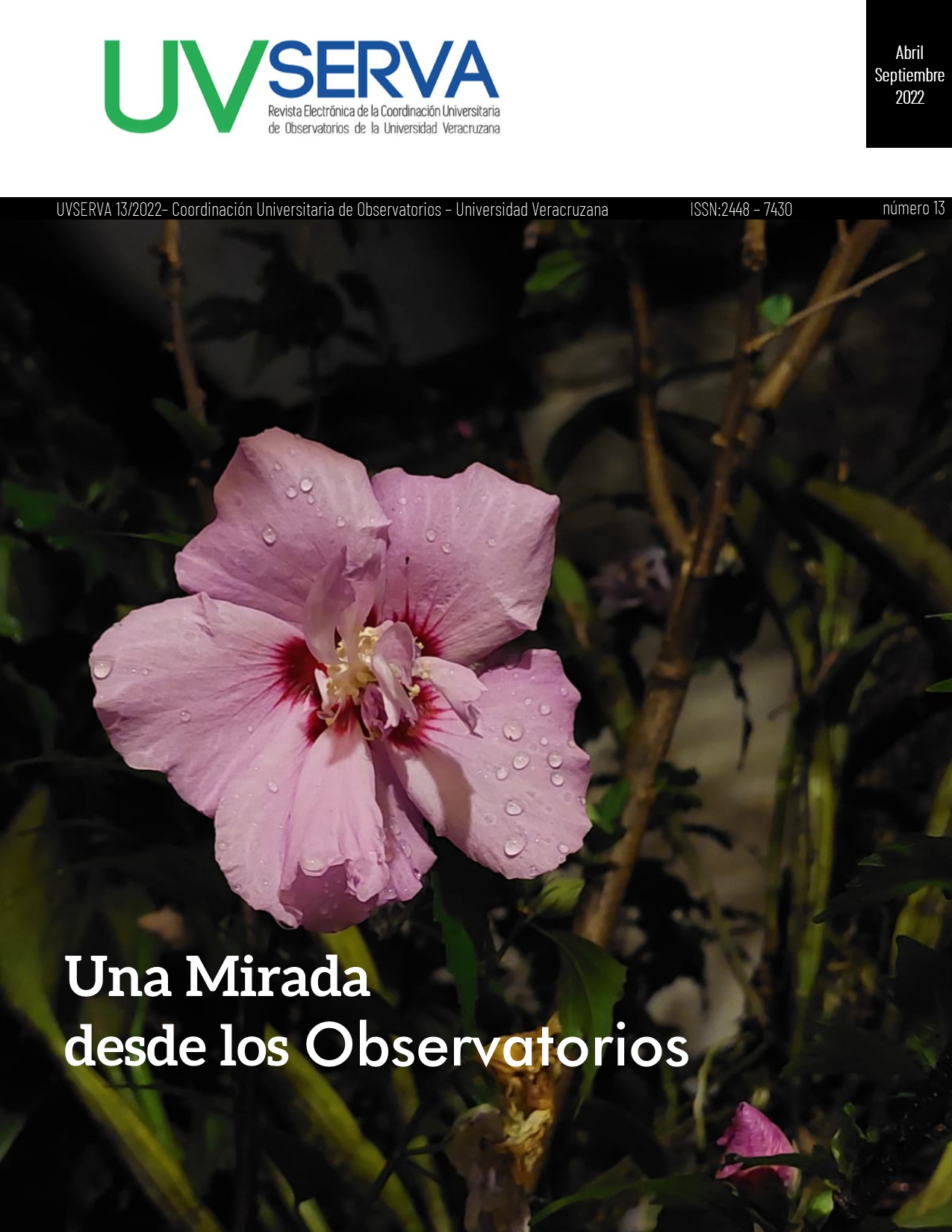Abstract
S
Standing out the characteristics of salt wedge estuaries, a specific monitoring plan for the Jamapa River was conceived that allowed to establish the salt stratification-level due to the yearly variation of river discharge in locations along the estuary. Stratification is a limiting factor for bottom and surface water interchange, promoting nutrient, pollutants and organic matter accumulation resulting in a possible algal bloom or depletion of dissolved oxygen. Stratification level was determined through the global salinity index Sp.
References
Aguilera-Arilla, M. J. Borderías Uribeondo, M. P. & González Yanci, M. P. (2010). Geografía general II: geografía humana.. UNED - Universidad Nacional de Educación a Distancia. https://elibro.net/en/lc/bibliotecauv/titulos/147927
Behmel, S., Damour, M., Ludwig, R., & Rodriguez, M. J. (2016). Water quality monitoring strategies—A review and future perspectives. Science of the Total Environment, 571, 1312-1329.
Cameron, W. M. and Pritchard, D. W. (1963). Estuaries. In Hill, M. N (ed.), The Sea, Vol. 2. John Wiley & Sons, New York, pp. 306–324.
Castañeda-Chávez, MDR., Lango-Reynoso, F., & Navarrete-Rodríguez, G. (2020). Study on Contamination by Heavy Metals in the Cotaxtla-Jamapa Basin with Influence in the Central Zone of the Gulf of Mexico. Water, Air, & Soil Pollution, 231(3), 1-13.
Geyer, W. R., & Ralston, D. K. (2011). 2.03-The dynamics of strongly stratified estuaries. Treatise on Estuarine and Coastal Science. Amsterdam: Elsevier, 37-52.
Gonenc, I. E., & Wolflin, J. P. (Eds.). (2004). Coastal lagoons: ecosystem processes and modeling for sustainable use and development. CRC Press.
Gray, W. B. & Shimshack, J. P. (2011). The Effectiveness of Environmental Monitoring and Enforcement: A Review of the Empirical Evidence, Review of Environmental Economics and Policy, Association of Environmental and Resource Economists, vol. 5(1), 3-24, Winter.
Haralambidou, K., Sylaios, G., & Tsihrintzis, V. A. (2010). Salt-wedge propagation in a Mediterranean micro-tidal river mouth. Estuarine, Coastal and Shelf Science, 90(4), 174-184.
Ibañez, C., Pont, D., & Prat, N. (1997). Characterization of the Ebre and Rhone estuaries: A basis for defining and classifying salt‐wedge estuaries. Limnology and Oceanography, 42(1), 89-101.
Kennish, M.J. (ed.), 2000. Estuary Restoration and Maintenance: The National Estuary Program. Boca Raton: CRC Press.
Lango-Reynoso, F., Castañeda-Chávez, M. D. R., Landeros-Sánchez, C., Galavíz-Villa, I., Navarrete-Rodríguez, G., & Soto-Estrada, A. (2013). Cd, Cu, Hg and Pb, and organochlorine pesticides in commercially important benthic organism's coastal lagoons SW Gulf of Mexico. Agricultural Science, 1(1), 63-79.
Mateos-Jasso, A., Zavala-Hidalgo, J., Romero-Centeno, R., & Allende-Arandía, M. E., 2012. Variability of the thermohaline structure in the northern Veracruz Coral Reef System, Mexico. Continental Shelf Research, 50, 30-40.
Nelson, B. W. (1970). Hydrography, sediment dispersal and recent historical development of the Po river delta, Italy: in J. P Morgan and RH Shaver, eds., Deltaic Sedimentation Modern and Ancient: SEP M. Spec. Publ, 15, I52-184.
Palomares, García J.M.(2010). Valoración de la calidad de los influentes y efluentes de las ganjas acuícolas de la Cuenca Baja del Río Jamapa, Veracruz. Tesis doctoral. Colegio de postgraduados. Institución de enseñanza e investigación en ciencias agrícolas. Tepetates, Manlio Fabio Altamirano, Veracruz.
Perales-Valdivia, H., Sanay-González, R., & Valle-Levinson, A. (2018). Effects of tides, wind and river discharge on the salt intrusion in a microtidal tropical estuary. Regional Studies in Marine Science, 24, 400-410.
Potter, I. C., Warwick, R. M., Hall, N. G., & Tweedley, J. R. (2015). The physico‐chemical characteristics, biota and fisheries of estuaries. Freshwater fisheries ecology, 48-79.
Riverón Enzástiga, ML., (2008). Análisis de la variabilidad de las descargas de agua de los principales ríos del sur de la cuenca hidrológica del Golfo de México. Ciudad de México. Tesis. UNAM.
Schelske, C. L., & Odum, E. P. (1962). Mechanisms maintaining high productivity in Georgia estuaries.
Sierra, J. P., Sánchez-Arcilla, A., Del Rı́o, J. G., Flos, J., Movellán, E., Mösso, C., & Romero, I. (2002). Spatial distribution of nutrients in the Ebro estuary and plume. Continental Shelf Research, 22(2), 361-378.
Torres-Beristáin, B., González López, G., Rustrián Portilla, E., & Houbron, E. (2013). Enfoque de cuenca para la identificación de fuentes de contaminación y evaluación de la calidad de un río, Veracruz, México. Revista internacional de contaminación ambiental, 29(3), 135-146.
Valle-Levinson, A. (2010). Definition and classification of estuaries. Contemporary issues in estuarine physics, 1, 1-10.
Vazquez Alcocer, M.(2020). Determinación y Caracterización del Clima Marítimo Extremo e Inundación Costera por Rebase de Oleaje en el Puerto de Veracruz, Veracruz. Tesis Licenciatura. Universidad de Guanajuato. División de Ingenierias. Campus Guanajuato, México.
Warwick, R. M., Tweedley, J. R., & Potter, I. C. (2018). Microtidal estuaries warrant special management measures that recognise their critical vulnerability to pollution and climate change. Marine pollution bulletin, 135, 41-46.
Worm, B., Barbier, E. B., Beaumont, N., Duffy, J. E., Folke, C., Halpern, B. S., & Watson, R. (2006). Impacts of biodiversity loss on ocean ecosystem services. Science, 314(5800), 787-790.
Zamudio-Alemán, R. E., Castañeda-Chávez, M. D. R., Lango-Reynoso, F., Galaviz-Villa, I., Amaro-Espejo, I. A., & Romero-González, L. (2014). Metales pesados en sedimento marino del Parque Nacional Sistema Arrecifal Veracruzano. Rev. Iberoam. Cienc, 1(4), 159-168.

This work is licensed under a Creative Commons Attribution-NonCommercial 4.0 International License.
Copyright (c) 2022 Rosario Sanay González, Héctor Perales Valdivia

